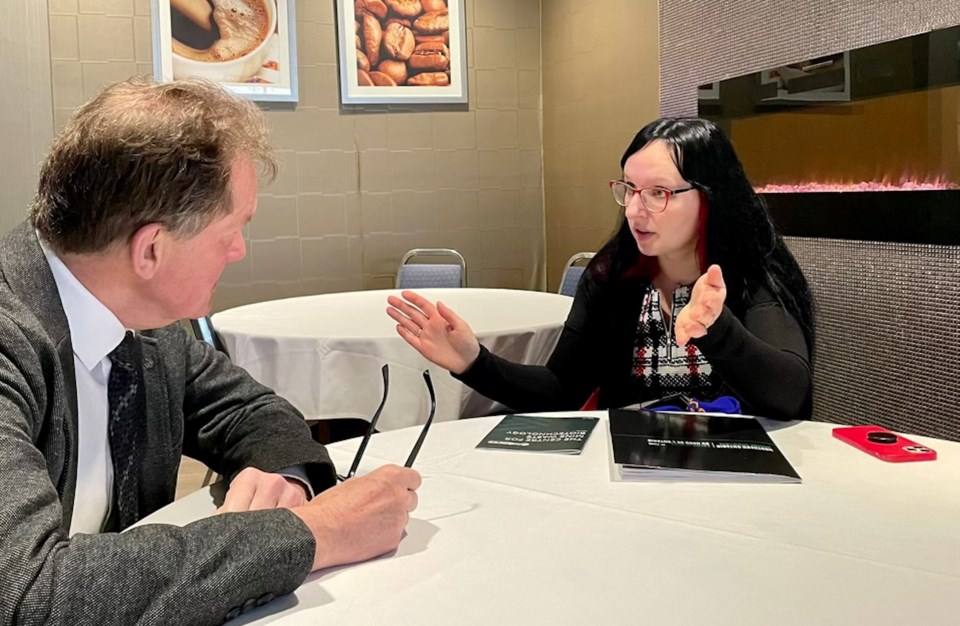A Canadian expert in the field of bio-mining hopes to break ground on a Centre for Mine Waste Technologies in Sudbury by the end of this year.
Nadia Mykytczuk, president of MIRARCO Mining Innovation, said she’s following an “aggressive timeline” in seeking to construct a $38-million innovation centre when she spoke before the provincial standing committee on finance and economic affairs in Sudbury, Jan.30, as part of the government’s 2024 pre-budget public hearings.
Mykytczuk brings to the table an environmentally friendly and zero-waste solution to extract valuable minerals from mine waste.
She works in a specialized field of research, concerning the bioleaching process, that has the potential to crack up a huge untapped opportunity in mining: to extract millions of dollars of valuable minerals left behind in waste piles of rock, known as tailings, at abandoned mine sites while cleaning up environmental legacy issues.
These minerals can’t be extracted using traditional processing methods but can be cost-effectively separated using biological means.
In the hearing, Mykytczuk didn’t specify where the centre will be built, the designers or builders involved, the array of industry partners, or how the project will be financed, but she’s expecting a raft of funding to arrive some time this year.
Mykytczuk later declined an interview request after the hearing, citing a busy schedule.
She told hearing panellists that MIRARCO has more than $40 million in grant applications and investor pitches under review by various federal and provincial funding agencies and the private sector.
Some funding has flowed in.
At last year’s PDAC mining show, her organization pocketed $1.6 million from the Northern Ontario Heritage Fund and Sudbury nickel miner Vale Base Metals to establish an industrial research chair program, headed by Mykytczuk, to work on these technologies and advance an environmentally friendly mining industry in the city.
The goal of the chair is to support and advance these sustainable mineral extraction technologies.
MIRARCO is an applied research arm of Laurentian University, working primarily with the mining industry. Mykytczuk has 18 years of experience in bio-mining and bio-remediation.
“Sudbury is home to one of largest tailings deposits in all of Canada,” said Mykytczuk, “and that legacy is there for thousands of years if we don’t do something to address it.”
Bioleaching is not a relatively new biotechnology. It was developed 40 years ago, and researchers around the world have been fine-tuning the process ever since. Sudbury is the latest proving ground.
The tailings ponds in the Sudbury basin contain hundreds of millions of tonnes of fine, powdered waste material that is chemically reactive and can cause much environmental damage.
Mykytczuk's team collects native and harmless bacteria at the site, takes it to the lab and develops tailor-made biotechnologies to break apart those elements in the same way that traditional smelter technology does, but does it in a way that’s much cheaper and with a lower carbon footprint.
The mineral value is extracted, and the harmful elements are removed, leaving behind only benign aggregate.
Her proposed $38-million Centre for Mine Waste Technologies has been on the books at MIRARCO for four years, the concept being to deliver custom-made solutions for each mining company.
“They will bring their challenges to us; we will work with them to develop solutions for them.”
The 45,000-square-foot building would contain industrial piloting space and analytical labs. According to the centre’s business plan, she said, one third of the initial capital investment would come from the private sector. Operating funds will come through various tiers of industry memberships.
Mykytczuk explained each tailings deposit is unique with different chemistries, elements and minerals to extract.
Vale in Sudbury, a committed industry partner and sponsor, has pyrrhotite tailings, rich in nickel and cobalt, which are coveted by battery manufacturers.
Mykytczuk said her team is piloting a biotechnology to deliver a viable processing flow sheet to Vale within two or three years' time to start the extraction of an estimated $8 billion to $10 billion worth of metals that remain in those tailings. She said they’re doing similar work with other industry members across Canada and internationally.
But there remain hurdles in advancing critical mineral projects in Ontario, and Mykytczuk said she wants to accelerate the commercialization of these biotechnologies, scale them up, and put them in the hands of industry. They have the means available to pilot and demonstrate these technologies.
Mykytczuk was asked the importance of this technology for the province in supplying critical minerals to the world and its potential application in providing a clean and green solution in places like the Ring of Fire.
She responded that Ontario is endowed with great mineral wealth. The deposits in this particular area of the James Bay are on that scale that can create the next Sudbury basin. But there remain plenty of development challenges in this remote and isolated part of the province.
Much can be learned from what’s been done in Sudbury, she said, alluding to the city’s landscape remediation, that can be applied to advance and support mining communities, including incorporating new technologies that don’t result in tailings storage ponds.
First Nations communities in the vicinity of the Ring of Fire will not support mine development “if we’re going to leave the same legacy.”
“There are lot of potential mistakes that we can make if we don’t do it properly."




